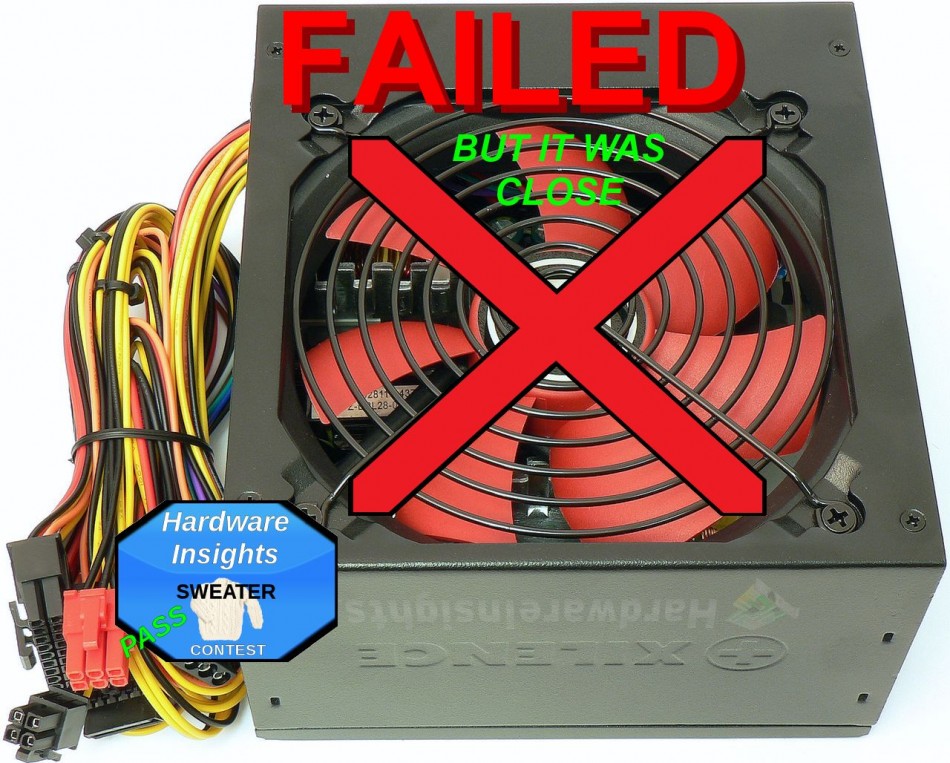Contents
- 1Introducing the Xilence XP400R6
- 1.1Packaging and accessories
- 2Connectors & cabling
- 2.1Casing & cooling
- 3Input filtering
- 4Primary side
- 4.1+5 V stand-by rail
- 5Secondary side
- 5.1Build quality
- 6Load testing
- 6.1Loading +5 V SB
- 6.2Voltage hold-up time
- 6.3Combined loading
- 6.4Combined loading ripple
- 6.5Crossloading, overloading
- 6.6Crossloading, overloading ripple
- 6.7Fan speed and temperatures
- 7Conclusion and evaluation
- 7.1Discussion
Conclusion and evaluation
The Xilence Performance C Series XP400R6 did not pass the combined and crossload testing in accordance with the ATX specification, so according to my evaluation methodology, it is not deserving of its evaluation. Although I do admit that it came really close. If only the voltage regulation was somewhat differently designed in favor of allowing the +5 V rail voltage to fall to around the level of 4.8 V, it would have most likely been OK. Or as I suggested earlier, if they had simply spec’d the power distribution label differently, to say 8 A on that rail with 16 A on +12 V – it may have actually met its rating.
Overall, I would say that this Chinese platform has potential. It has the potential to become a half decent yet inexpensive 300-500W unit. It especially has the potential to become a decent 300W unit with reasonable efficiency (I think 80 PLUS Bronze is definitely possible and perhaps even Silver could be achieved). Though for myself, I could very well live without any certification if the unit is able to at least deliver its advertised efficiency. Because such certification costs around 5000 US dollars (for 230V internal) as well as submitting two samples, it is making less and less sense for many manufacturers.
Just such a 300W unit with a single PCIe connector, plus one that can make use of full 4+4pin ATX 12 V connectors, is what thousands are waiting for. It would be capable of driving a pretty powerful computer (with an average 4-core CPU and some 75-100W graphics card). Instead, Xilence aimed this product at the masses whom are easily fooled by such an old trick like advertising peak instead of continuous power. It is good that such brands at least no longer dare advertise 400 W on an actual 250W unit (most likely because of couple lawsuits). I can still remember those times.
But at this time, I can state that the XP400R6 is not really that good of a unit. Though the ripple values were quite decent, the voltage regulation should have been better. And as for the promised protections, they were conspicuously absent during testing. On the other hand, you can easily find many equally inferior 250W units which cost less, or units which cost the same and should at least provide their claimed power ratings in spec. There are still many old 300-350W units on the market based on now obsolete Seasonic and FSP platforms which I would trust more than this on any day of the week. With its price actually higher in the Czech Republic, in a price per watt ratio, it sits price-wise on the higher side of the mainstream, in fact even nearing the high-end!

 Pros Pros |
+ actually managed to provide 400 W + voltage hold-up time and ripple in spec + OK efficiency + has 6pin PCIe connector |
 Cons Cons |
− bad crossload voltage regulation − bad capacitors − thin wires − low rated continuous power |
 Be aware of… Be aware of… |
/?\ buying this unit |

